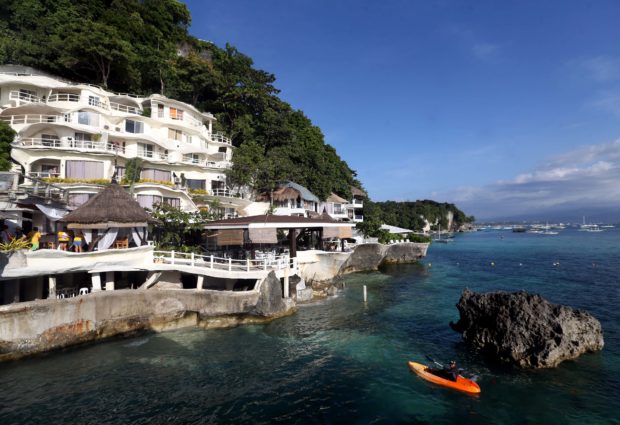
The owner of West Cove resort on Boracay Island, one of the local establishments cited for violations of environmental laws, has agreed to dismantle structures built on rock formations and those not covered by a lease agreement with the government. INQUIRER FILE PHOTO
Putting Boracay under a state of calamity would fast track the government’s effort to rehabilitate the island, Interior Officer-in-Charge Sec. Eduardo Año said on Wednesday.
Año said efforts to rehabilitate the famous tourist destination could not be implemented if establishments would continue to operate.
“It’s one of the options we’re considering because there is concern that the plan to rehabilitate Boracay Island cannot be achieved under normal circumstances, meaning when normal commercial activities are in operation,” Año said in a statement.
Año last week said the Department of the Interior and Local Government (DILG) was considering to declare Boracay under state of calamity for six months and shut down establishments for 60 days.
The proposal stemmed from President Rodrigo Duterte’s order to Environment Secretary Roy Cimatu to clean up Boracay, which he described as a “cesspool.”
He has also reminded local government officials that they may be liable for their failure to protect Boracay.
The President gave the DILG and the Department of Environment and Natural Resources (DENR) six months to implement “immediate action” to fully fix the island’s environmental issues.
READ: Local execs behind Boracay woes
Año said that under Republic Act No. 10121 or Disaster Risk Reduction and Management (DRRM) Act of 2010, the President is authorized to declare any cluster of barangays and other levels of local government units (LGUs) under a state of calamity, upon the recommendation of the National Disaster Risk Reduction and Management Council (NDRRMC).
The declaration would allow the national government and LGUs to utilize their respective calamity funds for the relief, recovery, and reconstruction of areas affected by “human-induced calamities and pollution” in Boracay, Año said.
“The current initiative to save Boracay is a statement of the national government to Filipinos and the whole world that this administration is just as serious in its environmental reforms as with other priorities in peace and order,” he pointed out.
“Boracay, having been ranked among top-three beach destinations in the globe for a couple of times, does not only deserve to be maintained as world-class in its sand and water but in its overall package including public safety which will be looked into during the rehab efforts,” he added.
DILG Assistant Secretary for Plans and Programs Epimaco V. Densing III said that engineers would perform a drainage audit in Boracay once the state of calamity is declared in the three barangays—Manoc-Manoc, Balabag, and Yapak—to check improper connections and disposal of waste into the waters.
Densing said that the targeted halt of business operations in Boracay for 60 days during the suggested six-month state of calamity in the area would not hurt Boracay’s tourism.
“It would allow intentional and purposive breathing space for Boracay to heal itself from human-induced degradation. And now that the world knows about Boracay being cleaned up, there is an expected influx of local and international tourists when Boracay is reopened because they would want to see how has the Island improved,” he said.
Aside from Boracay, Año said that other LGUs should now be on their toes in regulating and maintaining “environmental health” of their beaches in their localities such as in El Nido in Palawan, Panglao in Bohol, and Siargao in Surigao del Norte./ac